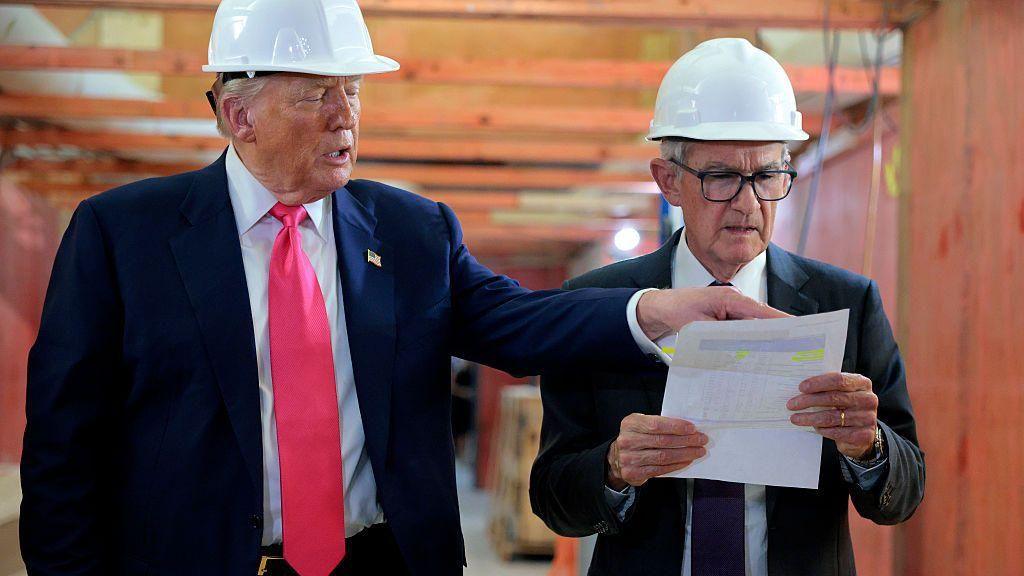For months, U.S. President Donald Trump has publicly criticized the head of the U.S. central bank via social media and statements to reporters.
On Wednesday, this dispute with Federal Reserve Chairman Jerome Powell played out in person, captured on camera, as the two clashed over renovation costs at buildings the White House alleges were mismanaged.
This tense exchange occurred amidst Trump’s escalating pressure on Powell, whom Trump believes is acting too slowly to cut interest rates.
Trump has repeatedly raised the possibility of dismissing Powell, only to quickly retract the idea, a move analysts suggest would destabilize financial markets and trigger a legal challenge.
Trump’s visit to the Fed marks the first by a sitting president in approximately two decades.
It precedes the Fed’s upcoming meeting in Washington next week, where policymakers are widely expected to maintain current interest rates.
Addressing reporters at the start of the tour, Trump stated that the administration was “taking a look at what’s happening” with the Fed’s $2.7 billion renovation project.
“It looks like it’s about $3.1 billion,” Trump said, as Powell stood beside him, shaking his head.
“I’m not aware of that,” Powell retorted. “I haven’t heard that from anybody at the Fed.”
Trump then produced a document from his jacket pocket, which Powell briefly reviewed before handing it back to the president, stating that he was “adding a third building” to the total.
“It’s a building that’s been built,” Trump countered.
Powell responded: “It’s a building that was built five years ago… it’s not new.”
A reporter then asked Trump, as a real estate developer, what he would do with a project manager who exceeded budget.
“Generally speaking, I’d fire him,” he responded.
Under U.S. law, governors of the central bank can only be removed “for cause,” typically interpreted as major misconduct.
This protection is intended to shield the bank from political pressure and ensure its leaders set policy in the best interests of the economy.
Legal experts have stated that cost overruns on the construction project would not typically meet that standard.
During the visit, Trump was asked if Powell could say anything to dissuade him from his criticism, to which he replied that he would “love to lower interest rates.”
Still, White House officials and Trump allies have focused on the renovation issue.
Trump – who has referred to Powell as a “numbskull,” “stubborn mule,” and “Trump hater” – told reporters this month that he believed mismanagement of the plan was “sort of” a fireable offense.
Democrats have accused Trump of attempting to use his attacks on Powell to “distract and deflect” attention, as he faces scrutiny over his handling of Jeffrey Epstein files.
They also argue that he is setting up Powell to be the scapegoat should the U.S. economy weaken.
Typically, the Fed lowers rates during economic downturns, hoping that easing borrowing will boost economic activity and stabilize employment.
Conversely, it raises interest rates when concerned about inflation, aiming to slow activity and reduce pressures on rising prices.
Economists suggest that Trump’s radical economic policy shifts, including higher tariffs, tax cuts, reduced government spending, and stricter immigration policies, have increased the risk of both scenarios, complicating the bank’s decision-making process.
Powell has stated his belief that the economy is stable enough for the Fed to observe developments before taking action.
Trump maintains that the bank should lower interest rates to alleviate the U.S. government’s significant borrowing costs and facilitate easier access to mortgages and other loans for Americans.
He asserts that inflation, which rose to 2.7% in June, is no longer a significant concern.
Powell was appointed by Trump to lead the bank in 2017 and renominated by Joe Biden. His term as chairman is set to conclude in May 2026.
The renovation project under scrutiny was initially approved in 2017 and intended to consolidate the bank’s operations.
It involves two buildings dating back to the 1930s.
The Fed attributes the cost overruns to issues such as unexpectedly discovering more asbestos and has disputed White House characterizations of other project aspects, including the presence of a “VIP elevator.”
The BBC’s James Cook analyzes the significance of U.S. President Donald Trump’s visit to Scotland.
His private visit is unusual, as U.S. presidents rarely promote their personal interests so publicly while in office.
The Trump administration has denied reports of overcrowding and substandard conditions in migrant intake facilities amidst increased deportation efforts.
The U.S. president and Federal Reserve chair disputed the cost and timeline of the Fed’s headquarters renovation project during a tour.
The accused claims his attorneys were unresponsive and that their views were “a million miles apart.”

